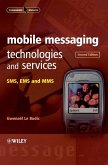Mobile Web services offer new possibilities and extraordinary rewards for the mobile telecommunications market.
Service-oriented architectures (SOAs) implemented with Web services are fundamentally changing business processes supported by distributed computing. These technologies bring forward the promise of services available at any time, in any place, and on any platform. Through mobile Web services, operators can offer new value-added services for their users, explore new business opportunities and increase revenue and customer retention.This expands the commercial opportunities for developers to promote their applications and enables solutions that work seamlessly across computer and mobile environments.
Mobile Web Services is a comprehensive, up-to-date and practical guide to adapting mobile Web services-based applications. The expert author team from Nokia explain in depth the software architecture and application development interfaces needed to develop solutions for these technologies.
Mobile Web Services: Architecture and Implementation:
_ Provides a complete and authoritative text on implementing mobile Web services.
_ Describes the mobile Service-Oriented Architecture (SOA) concept.
_ Covers the discovery, description and security of Web services.
_ Explains how to use Simple Object Access Protocol (SOAP) in Web service messaging.
_ Discusses the challenges and possibilities of mobile Web services, and gives case studies to illustrate the application of the technology.
_ Presents the Nokia Mobile Web Services platform.
_ Offers material on developing mobile Web service clients using C++ and Java.
This text is essential reading for wireless Web architects, mobile application developers and programmers, software developers, technical officers and consultants, as well as advanced students in Computer Science and Electrical Engineering.
Service-oriented architectures (SOAs) implemented with Web services are fundamentally changing business processes supported by distributed computing. These technologies bring forward the promise of services available at any time, in any place, and on any platform. Through mobile Web services, operators can offer new value-added services for their users, explore new business opportunities and increase revenue and customer retention.This expands the commercial opportunities for developers to promote their applications and enables solutions that work seamlessly across computer and mobile environments.
Mobile Web Services is a comprehensive, up-to-date and practical guide to adapting mobile Web services-based applications. The expert author team from Nokia explain in depth the software architecture and application development interfaces needed to develop solutions for these technologies.
Mobile Web Services: Architecture and Implementation:
_ Provides a complete and authoritative text on implementing mobile Web services.
_ Describes the mobile Service-Oriented Architecture (SOA) concept.
_ Covers the discovery, description and security of Web services.
_ Explains how to use Simple Object Access Protocol (SOAP) in Web service messaging.
_ Discusses the challenges and possibilities of mobile Web services, and gives case studies to illustrate the application of the technology.
_ Presents the Nokia Mobile Web Services platform.
_ Offers material on developing mobile Web service clients using C++ and Java.
This text is essential reading for wireless Web architects, mobile application developers and programmers, software developers, technical officers and consultants, as well as advanced students in Computer Science and Electrical Engineering.








